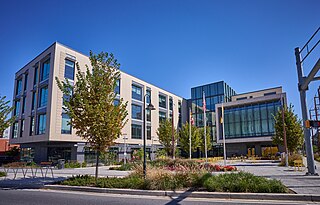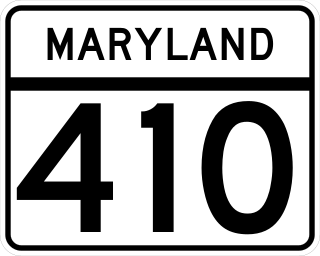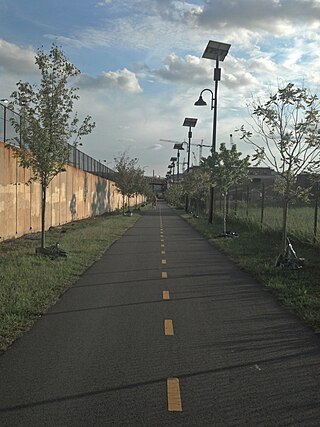Related Research Articles

Silver Spring is a census-designated place (CDP) in southeastern Montgomery County, Maryland, United States, near Washington, D.C. Although officially unincorporated, it is an edge city with a population of 81,015 at the 2020 census, making it the fifth-most-populous place in Maryland after Baltimore, Columbia, Germantown, and Waldorf.

Takoma Park is a city in Montgomery County, Maryland, United States. It is a suburb of Washington, and part of the Washington metropolitan area. Founded in 1883 and incorporated in 1890, Takoma Park, informally called "Azalea City", is a Tree City USA and a nuclear-free zone. A planned commuter suburb, it is situated along the Metropolitan Branch of the historic Baltimore and Ohio Railroad, just northeast of Washington, D.C., and it shares a border and history with the adjacent Washington, D.C. neighborhood of Takoma. It is governed by an elected mayor and six elected councilmembers, who form the city council, and an appointed city manager, under a council-manager style of government. The city's population was 17,629 at the 2020 census.

Montgomery College (MC) is a public community college in Montgomery County, Maryland.

College Park is a city in Prince George's County, Maryland, United States, located approximately four miles (6.4 km) from the northeast border of Washington, D.C. Its population was 34,740 at the 2020 United States census. It is the home of the University of Maryland, College Park.

The Red Line is a rapid transit line of the Washington Metro system, consisting of 27 stations in Montgomery County, Maryland, and Washington, D.C., in the United States. It is a primary line through downtown Washington and the oldest and busiest line in the system. It forms a long, narrow "U," capped by its terminal stations at Shady Grove and Glenmont.

Rockville station is an intermodal train station located in downtown Rockville, Maryland, United States. It is served by the Washington Metro Red Line, MARC Brunswick Line commuter trains, and Amtrak Floridian intercity trains.

Shady Grove station is a Washington Metro station in Redland, Maryland, United States. The station opened on December 15, 1984 as part of a four-stop extension of the Red Line from Grosvenor–Strathmore station to Shady Grove. The station is operated by the Washington Metropolitan Area Transit Authority (WMATA).

Fort Totten station is a Washington Metro station in northeastern Washington, D.C. It is one of the four major transfer points on the Metrorail system. It acts as a transfer point between the Green and Red Lines. It is the last station on the Green Line in the District of Columbia before heading into Maryland and the second to last for the Red Line. It is one of two stations with three levels, and is doubly unique in being the only multi-level transfer station built above ground and being the only such station to have island platforms on both levels, as opposed to just the lower level. The station's name comes from a Civil War-era fortification which itself was named after General Joseph Gilbert Totten, the Chief Engineer of the antebellum US Army.

Takoma station is a Washington Metro station on the Red Line in the Takoma neighborhood of Washington, D.C., bordering Takoma Park, Maryland. The station is considered to be located in part of Takoma Park's Historic District. It is the last station in the District of Columbia on the eastern end of the Red Line heading to Maryland, located east of the intersection of Blair Road NW and Cedar Street NW. The station's parking lot and bus stops are accessed from Eastern Avenue NW, which runs along the DC–Maryland line.

Silver Spring station is a train station on the Red Line of the Washington Metro and the Brunswick Line of the MARC Train commuter rail system. The Metro station averaged 4,536 daily riders in 2023, making it the 19th-busiest stop in the network and the busiest in the state of Maryland. Trains travelling south from the station quickly cross the border into Washington, D.C., while northbound trains head underground and make their way further into Montgomery County.

College Park–University of Maryland station is a Washington Metro and MARC station located in College Park, Maryland, near the University of Maryland, College Park campus. It is served by the Metro Green Line and limited service on the MARC Camden Line. The light rail Purple Line is planned to begin service at the station in 2027.

Takoma, Washington, D.C., is a neighborhood in Washington, D.C. It is located in Advisory Neighborhood Commission 4B, in the District's Fourth Ward, within the northwest quadrant. It borders the city of Takoma Park, Maryland.

Maryland Route 195 is a state highway in the U.S. state of Maryland. Known as Carroll Avenue, the state highway runs 1.90 miles (3.06 km) from Eastern Avenue at the District of Columbia boundary in Takoma Park north to MD 193 in Silver Spring. MD 195 is the main north–south state highway through Takoma Park in southeastern Montgomery County. The highway provides access to Washington Adventist University and Washington Adventist Hospital and crosses Sligo Creek on the Carroll Avenue Bridge. The state highway was constructed from Washington, D.C. to Silver Spring in the late 1920s on a road that has existed since the 19th century. The Carroll Avenue Bridge was built in 1932 as the third bridge at the site. Reconstruction of the bridge began in 2015 and was completed in 2017.

Maryland Route 410 (MD 410) is a state highway in the U.S. state of Maryland and known for most of its length as East–West Highway. The highway runs east to west for 13.92 miles (22.40 km) from MD 355 in Bethesda east to Pennsy Drive in Landover Hills. MD 410 serves as a major east–west commuter route through the inner northern suburbs of Washington, D.C., connecting the commercial districts of Bethesda, Silver Spring, and Hyattsville. In addition, the highway serves the industrial area of Landover Hills and the residential suburbs of Chevy Chase, Takoma Park, Chillum, Riverdale, and East Riverdale. The road also connects many of the arterial highways and freeways that head out of Washington. Additionally, it provides a highway connection to transit and commercial hubs centered around Washington Metro subway stations in Bethesda, Takoma Park, Hyattsville, Silver Spring, and New Carrollton–the latter two of which provide additional connections to MARC and Amtrak trains.

The Metropolitan Subdivision is a railroad line owned and operated by CSX Transportation in Washington, D.C. and Maryland.The 53-mile line runs from Washington, D.C., northwest to Weverton, Maryland, along the former Metropolitan Branch of the Baltimore and Ohio Railroad.

The Metropolitan Branch Trail is a partially-built American rail trail between the transit center in Silver Spring, Maryland, and Union Station in the District of Columbia. When it is completed it will run for 8 miles (13 km): one in Maryland and seven within Washington, D.C. The trail parallels Metrorail and CSX tracks along a right-of-way opened in 1873 as the Baltimore and Ohio Railroad (B&O)'s Metropolitan Branch.

Silver Spring station is a former train station on the Metropolitan Subdivision in Silver Spring in Montgomery County, Maryland. It was built in 1945 by the Baltimore and Ohio Railroad on the foundation of a previous station, a Victorian-style brick structure built in 1878. It served intercity trains until 1986 and commuter rail until 2000. Today, it is owned and operated as a museum by Montgomery Preservation, Inc., a non-profit organization.

Maryland Route 320 is a state highway in the U.S. state of Maryland. Known as Piney Branch Road, the highway runs 2.84 miles (4.57 km) from Eastern Avenue at the District of Columbia boundary in Takoma Park north to MD 650 in Adelphi. MD 320 is a southwest–northeast highway that connects Takoma Park and Silver Spring in southeastern Montgomery County with Adelphi in far western Prince George's County. The state highway originally extended from downtown Silver Spring to White Oak and connected with U.S. Route 29 at both ends. The Silver Spring–Adelphi portion of the highway was constructed in 1910. The segment through Takoma Park and the Adelphi–White Oak segment, which later became MD 650, were built in the early 1930s; the Takoma Park portion was built as MD 513. MD 320 was widened over its whole length in the late 1940s and reduced to its present course in the mid-1950s.

The College Park–Bethesda Line, designated Route J4, was a rush hour-only MetroExtra bus route operated by the Washington Metropolitan Area Transit Authority between the College Park–University of Maryland station of the Green and Yellow Lines of the Washington Metro and Bethesda station of the Red Line of the Washington Metro. The J4 operated throughout the neighborhoods in Prince George's and Montgomery counties in Maryland. This line ran along current construction for the upcoming Purple Line between College Park and Bethesda.

Forest Glen Park is an unincorporated community in Montgomery County, Maryland, United States, and a residential neighborhood within the Silver Spring census-designated place. The community is adjacent to Rock Creek, Rock Creek Regional Park, and to the United States Army's Forest Glen Annex.
References
- ↑ Bentley, Elizabeth Marple (May 1999). "The District's Frontier in 1884: Tradesmen Join Visionary to Shape Washington's First True Suburb". Takoma Voice. Historic Takoma.
- ↑ "The Metropolitan Branch & Takoma Park". The Historical Marker Database. Retrieved 4 November 2022.
- ↑ "B&O Metropolitan Branch Modern day photo tour". TrainWeb. Retrieved 4 November 2022.
- ↑ "Silver Spring Downtown and Adjacent Communities Plan Briefing, Montgomery County Planning Board, Item No. 7, 09-30-2021" (PDF). Montgomery Planning Board. Maryland National-Capital Parks and Planning Commission. Retrieved 4 November 2022.